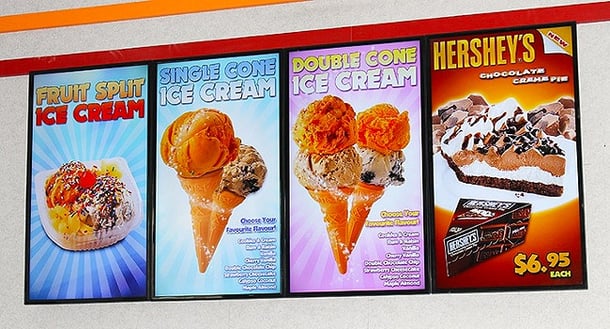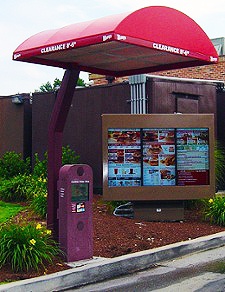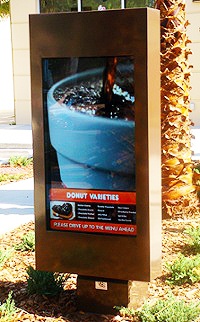
As Quick Service Restaurants (QSRs) install digital menu boards across the country, one might say, ‘It is cheaper to install interior digital boards at our restaurants. We do not want to deal with sourcing special, brighter, LCDs and environmentally sealed enclosures.' This could be true, but it is also true that approximately 60-70% of QSR customers are buying their chicken sandwiches, fries, and medium Coke at the drive-thru. If a restaurant only has digital menu boards on the inside, they are simply not influencing the majority of their customers (over two-thirds). With digital, the options are endless and with static, the options are limited - unless new menus are printed every time that the restaurant makes a change to their prices or food choices (wow, that is a lot of menus!).
4 Benefits of Switching to Digital Inside and Outside Simultaneously
-
Customer Engagement:
 What is the #1 reason to go digital both indoors and outdoors? To engage customers, both loyal and new; both inside of the restaurant and outside in the drive-thru. With flashy, dynamic graphics and easy-to-read menus, digital signage is eye-catching for the customer and will assist in choosing their meal quicker. Quick service restaurants will theoretically be able to service more customers in a more efficient way, because the menu boards are striking and less cluttered. Plus, beta testing can be done to see what is selling and what is simply not selling (remember the Burger King Satisfries? Neither do we). Fonts can be enlarged, colors can be modified, and the overall look and feel of the menu can constantly change depending on the current branding of the restaurant. This makes for a better and more engaging drive-thru experience.
What is the #1 reason to go digital both indoors and outdoors? To engage customers, both loyal and new; both inside of the restaurant and outside in the drive-thru. With flashy, dynamic graphics and easy-to-read menus, digital signage is eye-catching for the customer and will assist in choosing their meal quicker. Quick service restaurants will theoretically be able to service more customers in a more efficient way, because the menu boards are striking and less cluttered. Plus, beta testing can be done to see what is selling and what is simply not selling (remember the Burger King Satisfries? Neither do we). Fonts can be enlarged, colors can be modified, and the overall look and feel of the menu can constantly change depending on the current branding of the restaurant. This makes for a better and more engaging drive-thru experience. -
Ability to Update:
If a restaurant wants to change the price of their fresh cobb salad or their iced caramel coffee, then obviously, they need to change all of their menu boards to reflect the new price. With digital, it is simple. The software can be programmed to change all the boards at the same time. However, if a restaurant does not have outdoor digital menu boards, then the inside would reflect the new price and the outside would still reflect old pricing. This will cause confusion for both employees and customers. The restaurant could ultimately lose money by charging the lesser price at the place where most of their customers order. -
Feature Specials:
 In the winter of 2014, McDonald’s was forced to unload over 10 million pounds of chicken wings, because of poor sales. McDonald’s had to lower prices for their Mighty Wings, which meant revising menu boards across the country. If they had digital menus both outside and inside, then this price change would be quick and painless. Companies like Taco Bell and Sonic have embraced ‘happy hour drinks,’ which means the price of their drinks are lowered every day in the afternoon. With digital menu boards, this price can be pre-programmed to change at 2:00pm and return to the normal price when the clock strikes 4:00pm. Again, it is simple and eliminates confusion. Plus, a large portion of the digital board’s real estate can advertise various LTOs (Limited Time Offers). With digital, the restaurant has the opportunity to increase sales by making unknowing customers aware of the special. It also encourages drive-thru customers to try different beverages, which could lead to an increase in sales of more expensive drinks in the future (at the regular price, too!).
In the winter of 2014, McDonald’s was forced to unload over 10 million pounds of chicken wings, because of poor sales. McDonald’s had to lower prices for their Mighty Wings, which meant revising menu boards across the country. If they had digital menus both outside and inside, then this price change would be quick and painless. Companies like Taco Bell and Sonic have embraced ‘happy hour drinks,’ which means the price of their drinks are lowered every day in the afternoon. With digital menu boards, this price can be pre-programmed to change at 2:00pm and return to the normal price when the clock strikes 4:00pm. Again, it is simple and eliminates confusion. Plus, a large portion of the digital board’s real estate can advertise various LTOs (Limited Time Offers). With digital, the restaurant has the opportunity to increase sales by making unknowing customers aware of the special. It also encourages drive-thru customers to try different beverages, which could lead to an increase in sales of more expensive drinks in the future (at the regular price, too!). -
Consistency:
Overall, it makes good business sense to have digital menus both indoor and outdoor, so that everything at the restaurant is consistent and branded properly. Why change the indoor menu boards in a matter of a few minutes, and then waste time and money designing a new menu, making various alterations, and then waiting for it to be printed and installed? Change is good, especially when it is a quick change that can be updated time and time again. Once the digital boards are purchased and installed, the stress and time spent changing the menu, even one small price, goes away.
With the adoption of outdoor digital menu boards, research has shown that sales can increase over 8%. As prices for digital boards decrease, they can actually pay for themselves over a short amount of time. Now, that is a positive return on investment.



